Background
On August 20, 2020, Mowi’s salmon farm at Carradale North shifted position after its seabed anchors became dislodged during Storm Ellen. The farm consisted of 10 circular net pens containing a total of 550,000 salmon of approximately 4.2kgs in weight. Four pens were damaged, two of which experienced torn netting. Mowi have confirmed that 48,834 farmed fish have escaped.
We are working with our members, Marine Scotland and Mowi to monitor and mitigate where possible in an attempt to minimise the number of farmed fish entering the rivers draining into the Firth of Clyde. Fisheries Management Scotland have been informed of significant numbers of farmed fish caught by anglers in multiple rivers across Loch Lomond, Ayrshire, Clyde and Argyll. Fish have also been reported from Islay, River Annan, Border Esk, River Eden SAC, and the River Derwent.
Mooring line failure at the southern end of the pen group was identified as the root cause of the incident. Mowi report that this failure was due to abrasion when the feed barge mooring lines came into contact with pen grid mooring lines.
The Salmon Interactions Working Group (SIWG) (published April 2020) made a number of recommendations to address inadequacies in the current regulatory system, some of which are relevant to escapes of farmed fish. For example, it is not currently an offence to have an escape – the only offence is failure to report an escape or circumstances that may have led to an escape. Once the SIWG recommendations are taken forward the reformed regulatory system will require 100% of the fish to be retained in farms, minimum technical standards as well as a per fish fine for any escapes. We are actively working with the Scottish Government to ensure these recommendations are implemented as soon as possible. In the meantime, we are working with Marine Scotland and MOWI to mitigate the current situation to the best of our ability.
Fisheries Management Scotland have produced guidance on how to ID farmed fish and the steps that should be followed and are asking captures to be recorded in their central reporting form.
Reporting form for captured farmed fish
What are we doing?
Fisheries Management Scotland are working with our members to ensure everything is being done to monitor the situation and mitigate the impacts where possible. In addition to this, we have worked with Marine Scotland Science and Mowi to design a genetic monitoring project which will allow us, in partnership with our member District Salmon Fishery Boards and Fisheries Trusts, to assess and understand the impact of this escape. This will also form the basis for future monitoring and mitigation programmes which can be built into a reformed regulatory regime for fish farming in Scotland.
Identification of Farmed fish
When farmed fish are newly in wild systems, there can be a number of identifying features.
Often the dorsal fin is the most commonly damaged feature on a farmed fish but where doubt occurs other features may be looked at. Less obvious indicators include more spots than a wild fish. If fish have two or more of these features, then it should be classed as a farmed origin fish. Once these fish have been in the wild for a while, the distinction of these features may diminish and it could become harder to identify conclusively. Escapees at sea for some time will re-grow their fins perfectly but by running your finger along the leading edge of a farmed salmon’s pectoral fin it will feel bumpy in comparison to a wild’s smooth one. Anglers should remain vigilant with their catches and seek second opinions where doubt occurs.
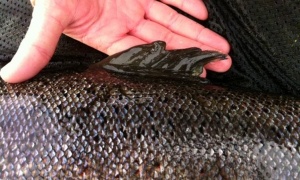
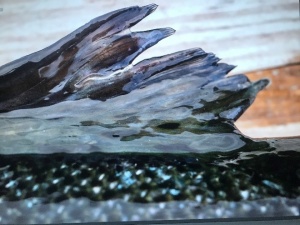
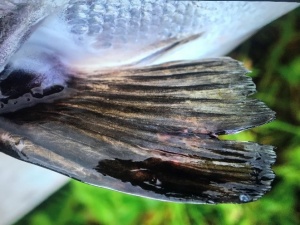
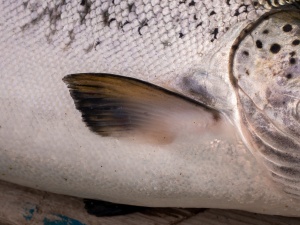
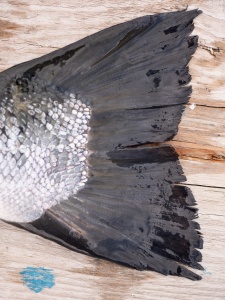
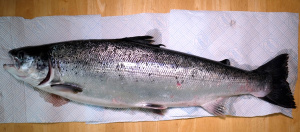

What can you do if you catch a farmed fish?
It is important that escaped fish are recorded centrally with Fisheries Management Scotland so when a fish is caught please fill in the online form. It is crucial this information is passed on to all those angling so that we have the information available in a consistent manner.
Following identification, escaped farmed fish should be humanely dispatched. Scale samples should be taken from behind the dorsal fin, and these should be sent to:
Stuart Brabbs, Ayrshire Rivers Trust 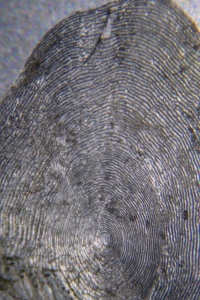
Braeside,
Burnbrae Lodge,
Mauchline
KA5 5HE
Scales should be stored in paper, not plastic; an envelope or kitchen roll are ideal. Scale samples will be read to ensure the fish was farmed and understand more of its life history.
Similar to what can be seen on a tree, salmon scales show growth rings. Farmed scales show rapid and uniform growth in comparison to wild fish whose growth is dependent on seasons and habitat.
